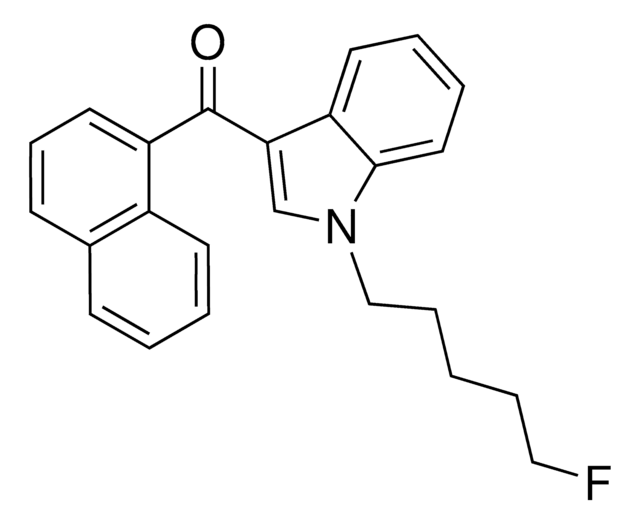추천 제품
분석
≥90% (HPLC)
형태
powder
저장 조건
desiccated
색상
white to beige
solubility
DMSO: >5 mg/mL
저장 온도
2-8°C
SMILES string
COc1ccc(cc1)C(=O)c2c(C)n(CCN3CCOCC3)c4cc(I)ccc24
InChI
1S/C23H25IN2O3/c1-16-22(23(27)17-3-6-19(28-2)7-4-17)20-8-5-18(24)15-21(20)26(16)10-9-25-11-13-29-14-12-25/h3-8,15H,9-14H2,1-2H3
InChI key
JHOTYHDSLIUKCJ-UHFFFAOYSA-N
애플리케이션
AM630 has been used:
- as a cannabinoid 2(CB2) inhibitor to study the analgesic effect exerted by polysaccharopeptide from Trametes versicolor (TPSP).
- as a CB2 antagonist along with β-caryophyllene (BCP) to study its effects on re-epithilialization of fibroblast cells.
- as a CB2 antagonist to study its interaction with 17-β-estradiol in primary human osteoblasts.
생화학적/생리학적 작용
AM630 is a selective CB2 cannabinoid antagonist/inverse agonist (Ki = 31.2 nM) with > 150-fold selectivity over CB1 receptors.
AM630 is an aminoalkylindole and acts as a competitive antagonist of CP 55,940 and WIN 55,212-2. It also behaves as a competitive antagonist of anandamide and (R)-(+)-arachidonyl-1′-hydroxy-2′-propylamide (AM356).
특징 및 장점
This compound is featured on the Cannabinoid Receptors page of the Handbook of Receptor Classification and Signal Transduction. To browse other handbook pages, click here.
신호어
Warning
유해 및 위험 성명서
예방조치 성명서
Hazard Classifications
Aquatic Acute 1 - Aquatic Chronic 1
Storage Class Code
11 - Combustible Solids
WGK
WGK 3
Flash Point (°F)
Not applicable
Flash Point (°C)
Not applicable
시험 성적서(COA)
제품의 로트/배치 번호를 입력하여 시험 성적서(COA)을 검색하십시오. 로트 및 배치 번호는 제품 라벨에 있는 ‘로트’ 또는 ‘배치’라는 용어 뒤에서 찾을 수 있습니다.
이미 열람한 고객
Sachiko Koyama et al.
PloS one, 14(12), e0216104-e0216104 (2019-12-17)
Beta-caryophyllene is an odoriferous bicyclic sesquiterpene found in various herbs and spices. Recently, it was found that beta-caryophyllene is a ligand of the cannabinoid receptor 2 (CB2). Activation of CB2 will decrease pain, a major signal for inflammatory responses. We
Massimo Nabissi et al.
Oncotarget, 7(47), 77543-77557 (2016-10-22)
Several studies showed a potential anti-tumor role for cannabinoids, by modulating cell signaling pathways involved in cancer cell proliferation, chemo-resistance and migration. Cannabidiol (CBD) was previously noted in multiple myeloma (MM), both alone and in synergy with the proteasome inhibitor
Marko Hojnik et al.
Biomedical reports, 3(4), 554-558 (2015-07-15)
The bone remodeling process is influenced by various factors, including estrogens and transmitters of the endocannabinoid system. In osteoblasts, cannabinoid receptors 2 (CB-2) are expressed at a much higher level compared to CB-1 receptors. Previous studies have shown that estrogens
K A Jenkin et al.
British journal of pharmacology, 173(7), 1128-1142 (2014-12-30)
In diabetic nephropathy agonism of CB2 receptors reduces albuminuria and podocyte loss; however, the role of CB2 receptors in obesity-related nephropathy is unknown. The aim of this study was to determine the role of CB2 receptors in a model of
R Pertwee et al.
Life sciences, 56(23-24), 1949-1955 (1995-01-01)
AM630 (iodopravadoline), a novel aminoalkylindole, has been found to attenuate the ability of a number of cannabinoids to inhibit electrically-evoked twitches of the mouse isolated vas deferens. It did not block the inhibitory effects of morphine or clonidine on the
자사의 과학자팀은 생명 과학, 재료 과학, 화학 합성, 크로마토그래피, 분석 및 기타 많은 영역을 포함한 모든 과학 분야에 경험이 있습니다..
고객지원팀으로 연락바랍니다.














